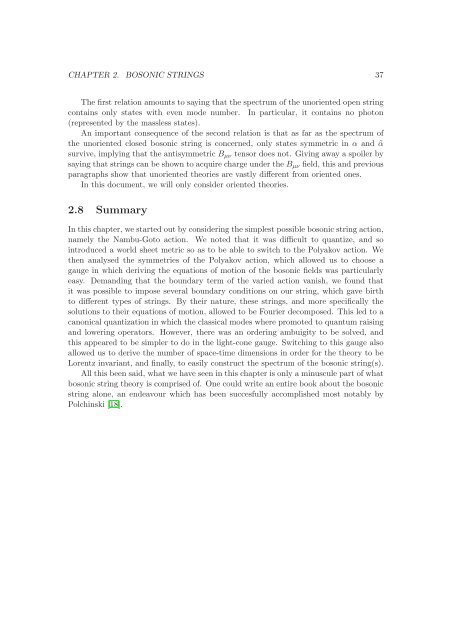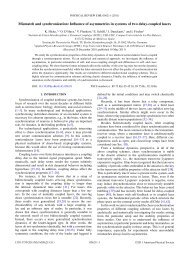DBI Analysis of Open String Bound States on Non-compact D-branes
DBI Analysis of Open String Bound States on Non-compact D-branes
DBI Analysis of Open String Bound States on Non-compact D-branes
Create successful ePaper yourself
Turn your PDF publications into a flip-book with our unique Google optimized e-Paper software.
CHAPTER 2. BOSONIC STRINGS 37The first relati<strong>on</strong> amounts to saying that the spectrum <str<strong>on</strong>g>of</str<strong>on</strong>g> the unoriented open stringc<strong>on</strong>tains <strong>on</strong>ly states with even mode number. In particular, it c<strong>on</strong>tains no phot<strong>on</strong>(represented by the massless states).An important c<strong>on</strong>sequence <str<strong>on</strong>g>of</str<strong>on</strong>g> the sec<strong>on</strong>d relati<strong>on</strong> is that as far as the spectrum <str<strong>on</strong>g>of</str<strong>on</strong>g>the unoriented closed bos<strong>on</strong>ic string is c<strong>on</strong>cerned, <strong>on</strong>ly states symmetric in α and ˜αsurvive, implying that the antisymmetric B µν tensor does not. Giving away a spoiler bysaying that strings can be shown to acquire charge under the B µν field, this and previousparagraphs show that unoriented theories are vastly different from oriented <strong>on</strong>es.In this document, we will <strong>on</strong>ly c<strong>on</strong>sider oriented theories.2.8 SummaryIn this chapter, we started out by c<strong>on</strong>sidering the simplest possible bos<strong>on</strong>ic string acti<strong>on</strong>,namely the Nambu-Goto acti<strong>on</strong>. We noted that it was difficult to quantize, and sointroduced a world sheet metric so as to be able to switch to the Polyakov acti<strong>on</strong>. Wethen analysed the symmetries <str<strong>on</strong>g>of</str<strong>on</strong>g> the Polyakov acti<strong>on</strong>, which allowed us to choose agauge in which deriving the equati<strong>on</strong>s <str<strong>on</strong>g>of</str<strong>on</strong>g> moti<strong>on</strong> <str<strong>on</strong>g>of</str<strong>on</strong>g> the bos<strong>on</strong>ic fields was particularlyeasy. Demanding that the boundary term <str<strong>on</strong>g>of</str<strong>on</strong>g> the varied acti<strong>on</strong> vanish, we found thatit was possible to impose several boundary c<strong>on</strong>diti<strong>on</strong>s <strong>on</strong> our string, which gave birthto different types <str<strong>on</strong>g>of</str<strong>on</strong>g> strings. By their nature, these strings, and more specifically thesoluti<strong>on</strong>s to their equati<strong>on</strong>s <str<strong>on</strong>g>of</str<strong>on</strong>g> moti<strong>on</strong>, allowed to be Fourier decomposed. This led to acan<strong>on</strong>ical quantizati<strong>on</strong> in which the classical modes where promoted to quantum raisingand lowering operators. However, there was an ordering ambuigity to be solved, andthis appeared to be simpler to do in the light-c<strong>on</strong>e gauge. Switching to this gauge alsoallowed us to derive the number <str<strong>on</strong>g>of</str<strong>on</strong>g> space-time dimensi<strong>on</strong>s in order for the theory to beLorentz invariant, and finally, to easily c<strong>on</strong>struct the spectrum <str<strong>on</strong>g>of</str<strong>on</strong>g> the bos<strong>on</strong>ic string(s).All this been said, what we have seen in this chapter is <strong>on</strong>ly a minuscule part <str<strong>on</strong>g>of</str<strong>on</strong>g> whatbos<strong>on</strong>ic string theory is comprised <str<strong>on</strong>g>of</str<strong>on</strong>g>. One could write an entire book about the bos<strong>on</strong>icstring al<strong>on</strong>e, an endeavour which has been succesfully accomplished most notably byPolchinski [18].
















